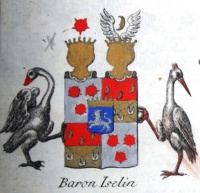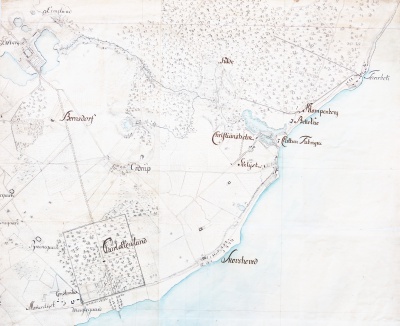Iselin, Reinhard
Born 4.8.1714 in Basel. Died 10.4.1781. Buried at Frederiks German Church in Christianshavn, Copenhagen (?)
Family
Father: Iselin, Johan Ludvig (Brugg), who was involved in the company Gürtlers & Wirts (Swiss Historical Dictionary) External link to Swiss Historical Dictionary
Mother: Schrotberger, Margaretha (?-1755)
Marriage: 9.2.1752 in Copenhagen, German Reformist Church to Fabritius de Tengnagel, Anna Elisabeth, born 20.8.1735 in Copenhagen, died 17.3.1786. Fabritius de Tengnagel, Anna Elisabeth was the daughter of bank commissioner, and director for Asiatisk Kompagni, Fabritius, Michael (1697–1746) and Koster, Anna Maria (1705–1775) (BioLek III)
Children: Daghter Mimi, married to the Count Rantzau, Christian Frederik Ernst (BioLek III). Another source claims her name was Iselin, Marie Margrethe (28.2.1753 - 14.9.1814) and that the couple were married on 14.6.1776 in Copenhagen, but that they were divorced on and Rantzau went on to marry Huth, Charlotte Wilhelmine von (Wikipedia)
Daughter Lisa, married to Calmette, Antoine de la (BioLek III). A collection of letters from Lise/Lisa de la Calmette, born Iselin, to Mrs. M. C. Schiönning dated to roughly 1782-1785 and some that are undated sits in the Royal Library's collection (Håndskriftssamlingen, Schiön 106 a - d, 4o. Breve til og fra M. C. Schiönning). The collection also includes correspondence between Lise de la Calmette, Mimi Rantzau and Ms. Scholten (?).
Timeline
1740: Upon spending some time learning the trade in Basel and Cologne, Iselin came to Copenhagen where he started working for House of Fabritius & Wever (BioLek III)
1748: Inducted into the Basel Safran Guild (Swiss Historical Dictionary)
1749: Established his own bank- and merchant house, House of Reinhard Iselin & Co. which quickly became one of the most influential merchant houses in Copenhagen (BioLek III) (Swiss Historical Dictionary). The same year Iselin was inducted into the Guild of Wholesale merchants in Copenhagen (Swiss Historical Dictionary)
1754: Established a cloth manufacture (BioLek III)
1755: Granted royal priviledge to print cotton on the Christiansholm estate near Klampenborg (BioLek III)
1755 - ?: Involved in the establishment of the Royal African Company (BioLek III)
1759-1769: Director of Asiatisk Kompagni. (BioLek III)
1766: Etatsraad (BioLek III)
1769: Konferensraad (BioLek III)
1772: Purchased the Ouerlooske tannery (BioLek III)
1776: Enobled, baron (BioLek III)
1777: In the newspaper "Kiøbenhavns Kongelig alene priviligerede Adresse-Contoirs Efterretninger (1759-1854), the wife of Iselin put in a notice saying that all business of Iselin & Compagnie should "cease", and that curators had taken over the company. It gives no further details of why this is, but clearly this is the onset of the demise of Iselin & Compagnie (Statsbiblioteket electronic newspaper resource)
Property
Iselingen
Rosenfeld (BioLek III)
Rosendal (BioLek III)
Rosenvænget in Copenhagen (probably the old Holmsted, Frederik estate where the cotton printing took place) (BioLek III)
A small estate in Lyngby, now Gramlille (BioLek III)
Iselin was considered one of the most affluent merchants, and was therefore also one of the merchants who supplied funds for the state loans at request of Bernstorff, J. H. E.. (BioLek III)

